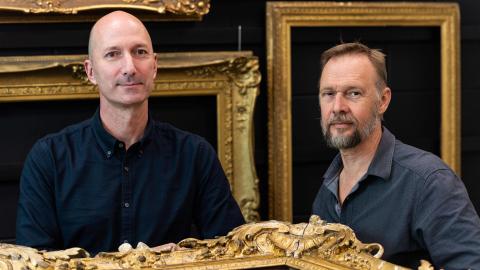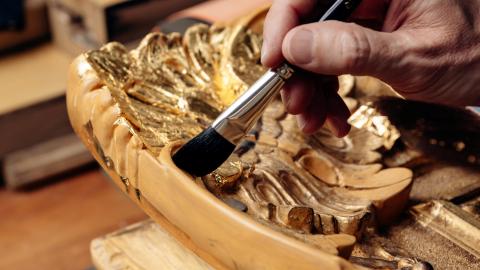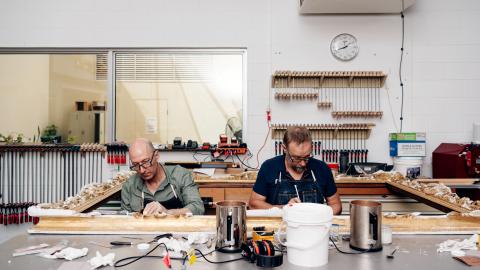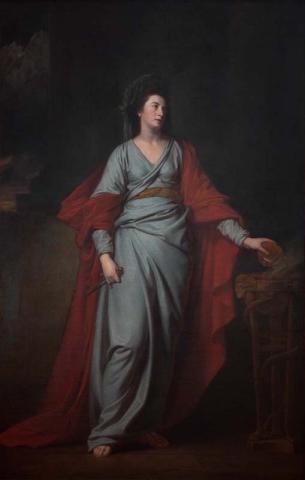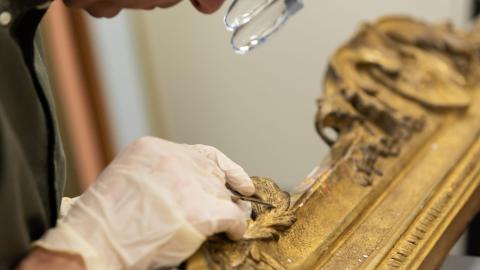Repairs and replicas
Restoring historical frames at QAGOMA
The beauty of working here is that we’re encouraged to maintain traditional techniques, which are a dying art around the world.
— Robert Zilli, Conservation Framer
QAGOMA is presently the only gallery in Australia with a framing studio of this kind, where experts both restore and make frames completely in-house. And despite the Gallery’s impressive collection of woodworking machines, often conservators Robert Zilli and Damian Buckley work by hand — sometimes using centuries-old methods — to perfect a frame.
At nearly three metres long, the frame for George Romney’s Mrs Yates as the Tragic Muse, Melpomene 1771 presents unique challenges, including using era-appropriate techniques to remove and repair centuries’ worth of poor quality restorations. Conserving frames at QAGOMA, for Robert and Damian, means not only caring for the frame in the context of its paired artwork, but also honouring each frame’s life, history and artistry.
Conservation of the Romney frame began mid–2022 and was completed in early 2024.
Robert Zilli and Damian Buckley at work on the Romney frame, QAG Framing Studio, July 2022 / Time-lapse video: C Callistemon, QAGOMA
Staging an intervention
Don’t tell this to the painting conservators, but I think the frames have quite tough lives compared to paintings.
— Damian Buckley, Conservation Framing Technician
ROBERT ZILLI: Before we do anything, we’re just looking over the frame again and again, getting to know the surface. When we undertake a considered surface clean, you also discover areas that were obscured by dirt or over-paint.
DAMIAN BUCKLEY: It takes you a while to understand what’s going on — what a frame’s problems are and why it’s got those problems.
RZ: What we’re doing is reinstating timber elements to re-carve and re-finish, using the same materials that the frame was originally made from. If [the Romney frame] were a nineteenth-century frame, we would have used ‘composition’ to make the repairs to the damaged ornament. [Also known as ‘compo’, composition is made of powdered chalk mixed with animal-based glue, resin (pine rosin) and linseed oil.] Compo is a thermoplastic material, in the sense that you can heat it up and it will become malleable and soft, and then as it cools it hardens to pretty much a rock consistency — quite a tough, hard material. The beauty of that is you mix the material up like dough; it has an amazing pine smell. However, as the Romney frame dates from the eighteenth century and is carved, repairs to the ornament must be carved in solid timber.

Robert Zilli conserving the frame for George Romney’s Mrs Yates as the Tragic Muse, Melpomene 1771, QAG Framing Studio, July 2022 / Photograph: N Harth, QAGOMA
DB: Don’t tell this to the painting conservators, but I think the frames have quite tough lives compared to paintings. The paintings do get over-painted and things happen to them, but with frames we find ‘interventions’ [DIY repairs] from all sorts of materials — really inappropriate and hard fills. This week I had to remove a nineteenth-century compo intervention that was much harder than the traditional materials in the frame and thus very difficult to remove without causing damage. And then, coming into the twentieth century, you get people using materials like car body filler. [These historical quick fixes] can be really time-consuming to undo in such a way that you’re not going to inflict any further damage.
RZ: There’s a box here of all the bits we’ve removed — these are all nineteenth- and twentieth-century repairs. So, there’s plaster repairs, there’s compo repairs — and again you can date them roughly by even the types of nails that are used to fix the repairs in place. Here’s a modern twentieth-century nail, there’s a nineteenth-century nail — so we take these off and know this happened roughly around that time. Even though they’re not good repairs, they still tell a story of what the frame has gone through over its life.
DB: And we don’t get out much, so we can find nails quite interesting — that can be the high point of the day!

Damian and Robert discover centuries’ worth of ‘interventions’ that tell the story of a frame’s life (as well as tell the history of nails), QAG Framing Studio, October 2022 / Photograph: C Callistemon, QAGOMA
Tools of the trade
RZ: There’s a whole range of tools we use — each one is pretty much indispensable for what we do. But the older I get, the tool I always go for is magnifying loupes; my eyesight is not getting any better. It can get a bit scary when you’re looking at a frame from further back, then put loupes on and go, ‘Oh my god, it’s worse than I thought’.
DB: You do lose a bit of perspective, though — you have to take them off every now and then. We also use a lot of dental tools, especially to remove layers that shouldn’t be there. This particular design — I think of it as a hockey stick — I have bonded with on a range of jobs, because it’s such a useful shape. During the process we’ve just finished, I have that in my hand for a number of hours every day.
RZ: That particular dental tool that Damian favours, you cannot get them in Australia. I’ve got a friend in Germany — I got her to send us over six of them. That’s how useful that particular tool is.

A selection of tools used in frame restoration, QAG Framing Studio, October 2022 / Photograph: C Callistemon, QAGOMA
DB: There is a bit of fear beforehand, when you’ve got your loupes on; your perspective of the world is gone and you’re just looking at a disaster. But then, once you’re exploring and having to do a bit of surgery, it always looks better by the end. When you’ve removed an intervention that shouldn’t have been there or that was completely compromised to start with. But it is daunting, from time to time, and you think, ‘Are we going to make it worse?’
RZ: And you need to remember to stand up occasionally and move around, because you do just get fixated on what you’re doing. You have to be confident you know what you’re doing and take your time. We’re not under the commercial time constraints of the people who carried out the previous restorations. When they used plaster and compo to repair a damaged frame, it was because they had to get the job in and out. We’re very lucky in that sense.

Robert Zilli, wearing magnifying loupes, absorbed in restoration of the Romney frame, QAG Framing Studio, July 2022 / Photograph: N Harth, QAGOMA
Making replica frames from scratch
RZ: In the QAG framing studio, everything — from historical replica frames all the way through to contemporary frames and our standard works-on-paper frames — is made in-house.
DB: Constructing frames in-house allows us to have full control of the whole process, including the design, precision fitting and custom finishes. It is a nuanced and evolving process and one that would be virtually impossible to type up on an order form for an external contractor.
RZ: The foundation I was given in Florence was quite traditional training — traditional materials and techniques — which we employ a lot when making replica frames here at the Gallery. If a painting comes into the Collection without an era-appropriate frame, we research our options, talk to curators, assistant directors — on occasion, even the director. When we have consensus on a design, we construct the frame using the same techniques that were used in that era. So, if we were to replicate a frame like this one — the Romney frame — it would be made using pretty much the same tools that were used in the mid-1700s, right down to the same techniques of applying the gold leaf. That said, very, very rarely, we buy commercially made moulding for temporary exhibitions.
DB: Yes, for something that’s coming from overseas on loan and will be returned overseas — they rarely come framed. Even the standard frames we make in-house are an investment in time and materials and we try and bring them to a very high standard, because we want them to last as long as possible. But if the artwork is only going to be in that frame for three months and then gone, our time and resources are better spent elsewhere.

Damian Buckley prepares a new frame for a QAGOMA exhibition, using a combination of traditional and modern techniques, May 2021 / Photograph: J Ruckli, QAGOMA
